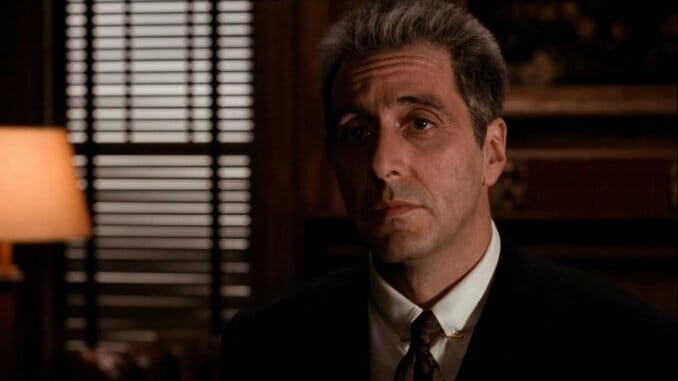What’s Different in The Godfather Coda: The Death of Michael Corleone? Not Enough To Change Its Vices (or Virtues) 30 Years Later

The first question raised by The Godfather Coda: The Death of Michael Corleone, Francis Ford Coppola’s remaster/re-edit of his 1990 film The Godfather Part III, is “What’s different?” I’ll spoil that for you: Not much, apart from a change to the very last shot of the original version that is minor in its execution. Besides a reshuffling of one or two scenes, I could detect only a few significant changes from the original, and at least some were subtractive rather than additive. There’s a tad more suspense during the final few scenes in Sicily, for example, because they cut some of Eli Wallach’s skullduggery. Those looking to this edit for some grand change in the original film’s themes will come out unsure they clicked on the right rental. Those looking to risk their health to see it in any theaters exhibiting it should really, really not do that.
The second question the film raises is tied up with all of the complex reasons Part III is argued about so passionately among a certain subset of film fan: What is it about tragedy that draws us? Like horror, it is a seeming contradiction that we want to be entertained by seeing downfall and disaster. It must be a noble figure who falls—our doomed protagonist needs to be a real pezzonovante. And it must stem from their own flawed character: Lear’s pride causes him to drive away the one daughter who truly loves him. Hamlet is consumed by fear and vengeance in equal measure. Arthur bangs his sister. Real tragedy of the Shakespearean or the Arthurian variety is about inevitability.
If we want to know Michael’s cardinal sin, though, Part II already provides it. He’s been telling himself that every rotten thing he’s done has been to protect his family, but the truth is that he’s mostly been doing it for his own stubborn pride and independence. The streak of pride that drove him to enlist in the Marines out of a desire to hurt his father is the same one that drove him to cut his wife out of his life and kill his own brother. In that light, The Godfather Part III has always seemed extraneous. It even ends in much the same way the previous film in the trilogy did: With Michael alone, brooding on his own authorship of his despair.

Add to this a litany of other complaints (Sofia Coppola’s acting is not good, why could they get Lucy Mancini’s original actor back but not Robert Duvall, why weren’t all these mafiosos who have decades-long loyalties to and grudges against Michael in the first two movies, etc.), and it’s understandable why so many view this final part of Michael Corleone’s bildungsroman as inferior to the two films that came before it, which are two of the best movies in film history. I still like the finale, though no special thanks to this new version. And in a few key ways, Part III brings the story begun in The Godfather to a more gut-wrenching conclusion than even the relentlessly grim Part II.
At least one edit helps set the stakes early on, as the Coda version opens with Michael (Al Pacino), now entering old age, speaking with Archbishop Gilday (Donal Donnelly), laying bare the central scheme of the film right away: The Vatican Bank is underwater and Michael believes he can use his vast fortune as leverage to gain a controlling stake in an international real estate company that the church owns. In the process, he’ll wash his family’s filthy money clean, and finally achieve the legitimacy his father always wanted for the family.

Michael is feted and celebrated publicly, but as always it’s a thin veneer: At the same party honoring him as a generous philanthropist, he has to settle a dispute between his hot-headed nephew Vincent (Andy Garcia) and Joey Zasa (Joe Mantegna), the strutting mobster who has stepped into Michael’s former role as leader of the New York family. Vincent, we learn, is the illegitimate son of Michael’s brother, Sonny—the result of a dalliance we saw in one of the first scenes of the first movie.
-

-

-

-

-

-

-

-

-

-

-

-

-

-

-

-

-

-

-

-

-

-

-

-

-

-

-

-

-

-

-

-

-

-

-

-

-

-

-

-









































